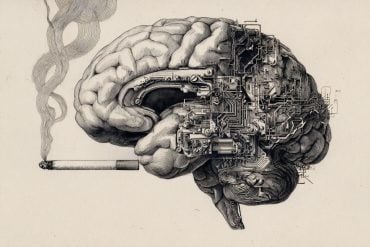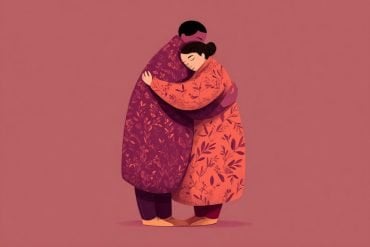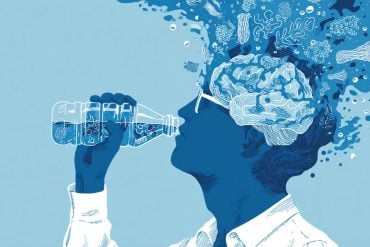Summary: Aesthetic experience is not just limited to the visual features of a piece of art, but also the moment at which it is viewed.
Source: UCL
How much someone likes a piece of artwork can impact their memory of when they first encountered it and which direction they were facing, finds new UCL-led research.
The findings show that aesthetic experience is not limited to just the visual features of a piece of artwork, but also the moment in which it was viewed.
The study, published in PNAS, asked 124 participants to look around a virtual reality art gallery, which featured 48 selected abstract artworks by internationally-recognized digital artists, including Sara Ludy and Yoshi Sodeoka.
Participants navigated through the on-screen gallery using arrow keys on a computer keyboard, as in a computer game. This meant that they had to make a deliberate action to turn to look at each picture.
After they visited the gallery researchers asked the participants to perform three tasks, focusing on recognition, spatial memory, and liking, respectively.
First, participants viewed several artworks and reported on whether they had just seen them in the gallery or not.
Next, they were asked to place artworks on a museum map, and to indicate in which room, and on which wall they had seen the picture, as a test of spatial memory.
Finally, participants were asked to rate how much they liked each piece of artwork, using a sliding scale.
The researchers found that the more a participant liked a piece of artwork, the better they remembered which wall of the gallery they had seen it on, i.e. which direction they were facing during the visit.
Lead author, Dr. Mariana Babo-Rebelo (UCL Institute of Cognitive Neuroscience), said, “Our work suggests a new component in the way people respond to art.”
“The actions that we make as we navigate towards an artwork have been neglected up to now, but our experiments show that the way we turn and orient towards an artwork is associated with our aesthetic response to it, and with the experience we retain after the aesthetic encounter.”
“This suggests an important role for visual first-person perspective in aesthetic experience. First-person perspective could act as a mental glue that binds the artwork itself to the way we subjectively respond to it.”

The researchers tested these findings with two additional studies involving over 150 further participants. One study required participants to focus on abstractness of artworks rather than on how much they liked them, while the other administered the memory test 24 hours later.
Again, they also found the same association between whether the viewer liked a piece of artwork and how well they remembered which direction they were facing when they saw it. This suggests that the link between liking and remembering facing direction is not just due to thinking about liking, and that the link endures in memory.
Professor Patrick Haggard (UCL Psychology & Language Sciences) who supervised the study, said, “It’s an old adage that ‘beauty is in the eye of the beholder’. But studies in experimental esthetics still tend either to search for intrinsic properties of art objects that could explain their aesthetic value, or just to describe how individuals differ in their aesthetic responses.”
“The research we report suggests why these purely objective or purely subjective approaches to esthetics can often disappoint. We think these approaches may both underestimate the crucial role of links between liking an artwork, and the first-person perspective.”
“When we like something, we store in memory not only the thing we like, but the spatial details of the moment when we discovered it. This feature of aesthetic memory could explain why our encounter with an artwork can often be so salient, and apparently even life-changing in some cases.”
The virtual gallery was created alongside digital art gallery, MoCDA, and image studio Hobs3D.
About this art, memory and neuroscience research news
Author: Chris Lane
Source: UCL
Contact: Chris Lane – UCL
Image: The image is in the public domain
Original Research: Closed access.
“Aesthetic experience enhances first-person spatial representation” by Mariana Babo-Rebelo et al. PNAS
Abstract
Aesthetic experience enhances first-person spatial representation
Episodic autobiographical memories are characterized by a spatial context and an affective component. But how do affective and spatial aspects interact? Does affect modulate the way we encode the spatial context of events?
We investigated how one element of affect, namely aesthetic liking, modulates memory for location, in three online experiments (n = 124, 79, and 80).
Participants visited a professionally curated virtual art exhibition. They then relocated previously viewed artworks on the museum map and reported how much they liked them.
Across all experiments, liking an artwork was associated with increased ability to recall the wall on which it was hung. The effect was not explained by viewing time and appeared to modulate recognition speed. The liking-wall memory effect remained when participants attended to abstractness, rather than liking, and when testing occurred 24 h after the museum visit.
Liking also modulated memory for the room where a work of art was hung, but this effect primarily involved reduced room memory for disliked artworks. Further, the liking-wall memory effect remained after controlling for effects of room memory. Recalling the wall requires recalling one’s facing direction, so our findings suggest that positive aesthetic experiences enhance first-person spatial representations.
More generally, a first-person component of positive affect transfers to wider spatial representation and facilitates the encoding of locations in a subject-centered reference frame. Affect and spatial representations are therefore important, and linked, elements of sentience and subjectivity.
Memories of aesthetic experiences are also spatial memories of how we encountered a work of art. This linkage may have implications for museum design.







